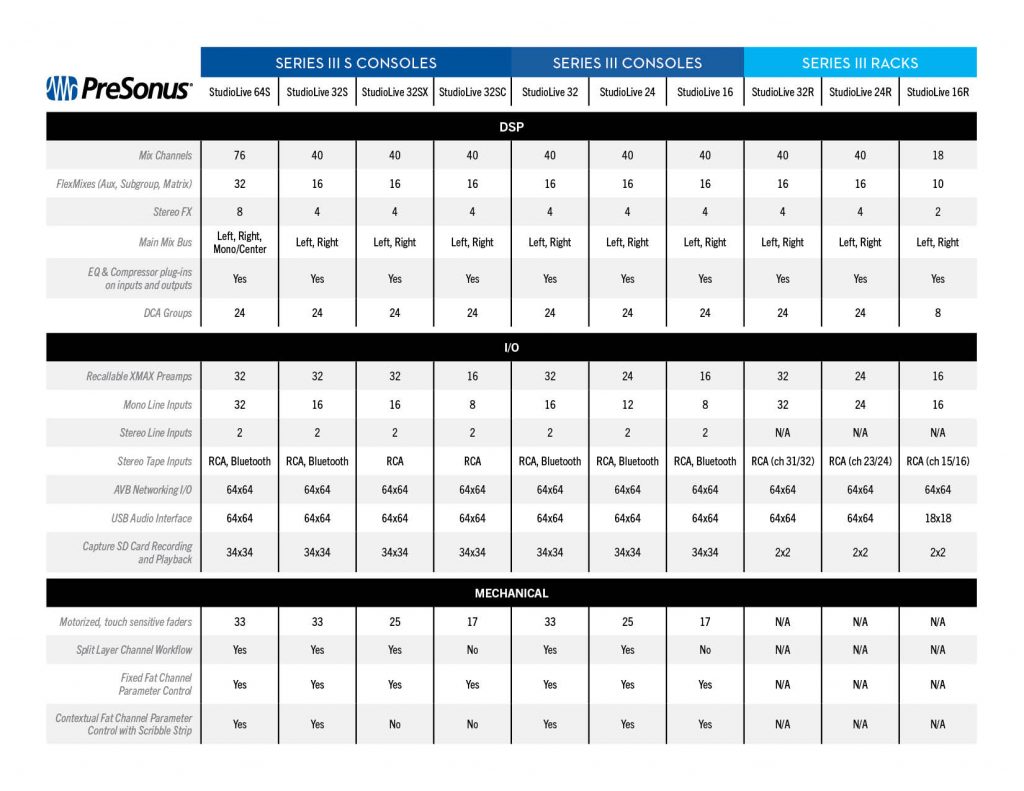Author Archives: Ryan Roullard
Important! macOS 10.15 Catalina Notice

Apple is poised to release its next operating system, macOS X 10.15, “Catalina,” sometime in October of 2019. PreSonus has been working with Apple to qualify pre-release versions of this new OS with all of our products.
We have found changes in Catalina that affect compatibility with PreSonus hardware and software. Remain on current versions of macOS until further notice. We ask that you please wait for us to announce compatibility before updating your OS.
In the meantime, please be advised:
- Studio One version 4.5.4 is required to run Studio One under 10.15.
- Izotope Neutron Elements and Klanghelm SDRR2Tube will not install under 10.15.
- Arturia Analog Lite, and StudioLinked Trophies will at first not install— you must CTRL+Click (or right click) and select “Open” to install them.
- Check your third-party plug-in developers’ websites for updates, as many of them may not install or run correctly under 10.15, and will need updates themselves to work correctly.
- Some of the Studio Magic Plug-ins will not run under 10.15.
- Universal Control 3.1 and older versions are not supported and will not open sample rate settings correctly on macOS X 10.15 Catalina.
- An update to Universal Control will be necessary to access these settings. This update will be announced as soon as it’s ready for use with 10.15.
- Universal Control 1.7.6 for FireStudio interfaces and StudioLive 24.4.2, 16.4.2 and 16.0.2 will not install on macOS X 10.15 Catalina.
- An update to Universal Control will be announced as soon as it’s ready for use with 10.15.
- StudioLive Series III mixers will not work with macOS X 10.15 without a firmware update.
- We are planning a public beta of this firmware update to be available soon after 10.15 becomes available.
- StudioLive 16.0.2. USB will not work with 10.15, please stay on 10.14 or a previously-supported OS until further notice.
We will provide an update when we have qualified 10.15 for use with our products and what updates are needed to ensure proper compatibility.
Thank you!
PreSonus Team
Please also see the following article:
Studio One Prime videos
Check it out! Gregor’s got a new series of videos for new users of Studio One Prime. He covers everything from installation and setup to basic beatmaking, and even time-stretching and working with Ableton Live.
More to come from Gregor soon!
Want to make some music? Get started with Studio One Prime here.
Coming soon… Mix the Music!
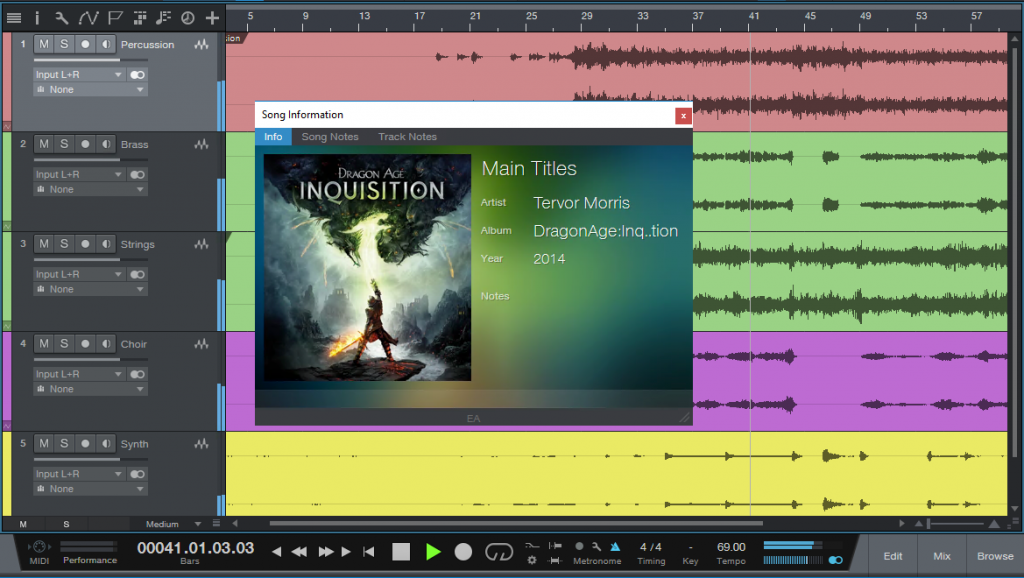 What’s Mix The Music?
What’s Mix The Music?
Mix The Music is a new online store specializing in multitrack audio files that allows producers, mix engineers, musicians, and… well, anyone to legally download, listen to, and re-mix songs using the original multitracks as recorded by major artists and film/game composers.

Who are multitracks for?
You! Music fans, amateur and professional audio engineers, DJs, teachers, and students can all benefit from multitrack audio. Once downloaded, you have independent access to the original individual recorded instrument and vocal tracks like isolated bass, drums, guitar, keys, and more. This lets you:
- Hear how classic recordings were created
- Hear every nuance of your favorite performer’s instrumental techniques
- Play along with legendary artists with exactly the mix that works for you
- Even record your own parts alongside the heaviest hitters in the music world
What styles of music are available?
We’ve got something for everybody—contemporary and classic hits, film scores, video game scores, and more. Even better, our content will continue to rapidly grow with more and more songs from top artists across all genres.
What labels/entities are participating in Mix The Music?
Major label tracks from Universal Music Group, Sony, Paramount, EA, and more are now available in a new .multitrack format containing the original stems. There are many more tracks on the way from dozens of labels and artists, the store is expected to grow rapidly.
How do I open up these multitracks and begin exploring?
Our files use the new .multitrack audio format developed by PreSonus Software Ltd., and as such are available to be opened and processed exclusively in PreSonus Studio One 4—Prime, Artist, and Professional editions. Mix The Music makes it easy and secure to access this never-before-available content—and now any Studio One user can listen to, explore, mix, and remix multitracks from major label artists!
Can I release my own re-mixes of songs from Mix The Music and sell them?
No. The music licenses in question do not allow for this. This is all about your personal learning and enjoyment.
Sounds great! When can I get involved?
Mix The Music will be launching in October, follow the link to learn more: http://www.mixthemusic.com/welcome
Craig Anderton Books
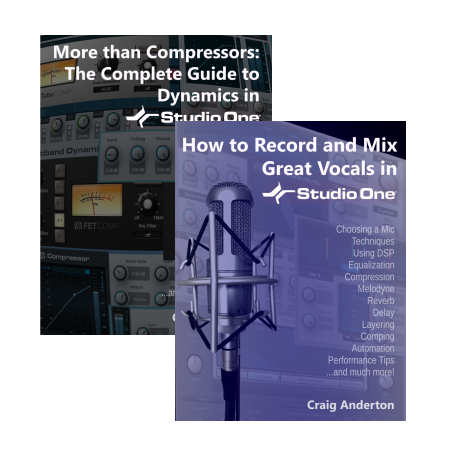 Sometimes a product comes along that’s a certified hit—and Craig Anderton’s downloadable eBooks certainly qualify.
Sometimes a product comes along that’s a certified hit—and Craig Anderton’s downloadable eBooks certainly qualify.
How to Record and Mix Great Vocals, released in January, has helped thousands of Studio One owners record world-class vocals. In June, More than Compressors – the Complete Guide to Dynamics in Studio One appeared, and de-mystified the sometimes complex applications of Studio One’s sophisticated dynamics control processors. The book impressed Studio One developer Arnd Kaiser so much he said “This is could easily become the de-facto reference for Studio One users on all things ‘dynamics.’ Very cool—and highly recommended.” We couldn’t agree more! Both eBooks are currently in the PreSonus shop for the low price of $9.99 each, and will expand your knowledge of Studio One exponentially.
Save 30% on Woodwind Bundle for Notion in July 2019!
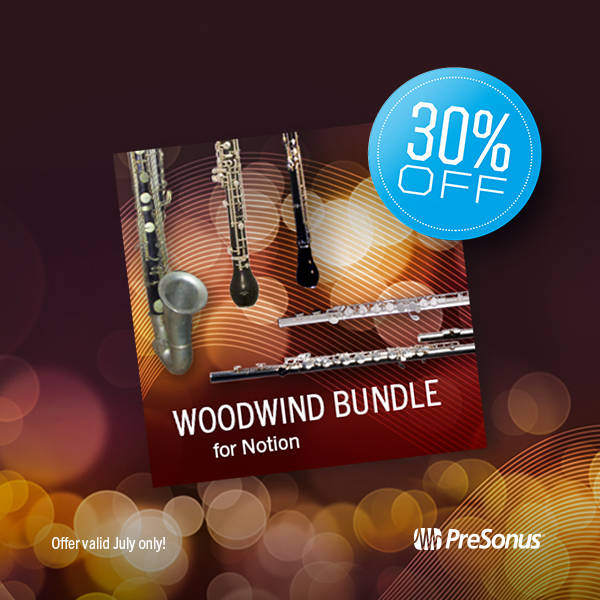 Get six Notion Add-ons for one low price! T his bundle includes the following woodwind instruments:
Get six Notion Add-ons for one low price! T his bundle includes the following woodwind instruments:
- Alto Flute
- Legato, Vibrato, Staccato, Flutter Tongue, Trills
- Bass Flute
- Legato, Vibrato, Staccato, Flutter Tongue, Trills
- Contrabass Clarinet (wooden)
- Legato, Staccato, Trills
- Basset Horn
- Legato, Staccato, Trills
- Oboe d’amore
- Legato, Vibrato, Staccato, Trills
- Bass Oboe
- Legato, Vibrato, Staccato, Trills
This offer ends July 31 – act fast!
Click here to shop!
New Low Price on Eris MTM Monitors!
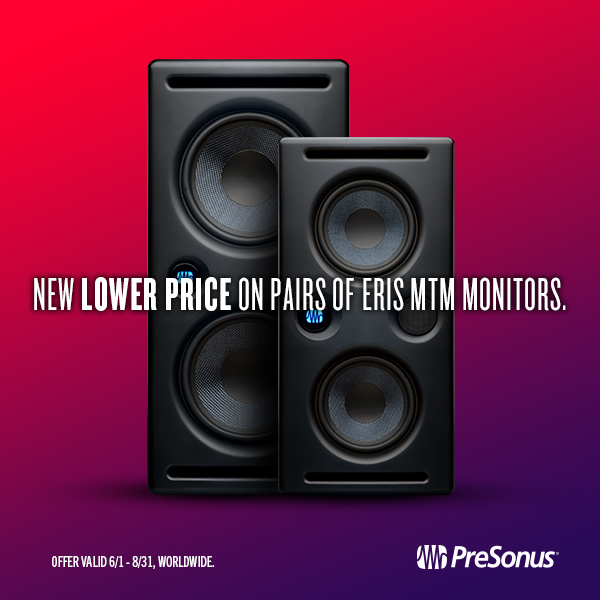 Great news! We’ve got an instant rebate going on the Eris E44 and E66 Monitors! That means no rebate form, no PDFs, no filling out paperwork—just lower prices on checkout!
Great news! We’ve got an instant rebate going on the Eris E44 and E66 Monitors! That means no rebate form, no PDFs, no filling out paperwork—just lower prices on checkout!
The Eris E44 and E66 deliver an expanded and highly accurate frequency response and the widest stereo field available in their class. The nested Midwoofer-Tweeter-Midwoofer (MTM, also known as “D’Appolito”) configuration offers improved off-axis response and spatial resolution. The result is a more consistent listening experience, smoother frequency response, and an ultra-wide, detailed stereo soundstage.
“There is plenty of sonic depth while maintaining clarity, regardless of the audio source.”
—Chris Devine, Performer Magazine
Pricing will vary a little bit regionally, but in the USA, the E44 is now $199, and the E66 is now $299.
Nektar Technology Integration for Studio One is here!
NektarTech just announced their new DAW Integration for Studio One!
The new integration delivers a completely transparent control experience including features such as display of track and parameter names, extended transport control, project navigation, mixer operation, tweaking of virtual instruments and instant control of any selected parameter in Studio One.
Being able to tweak virtual instruments like hardware synths or mixing with full parameter feedback considerably speeds up the workflow. Dedicated “Mixer” and “Instrument” mode buttons switch Panorama’s control surface to take over the corresponding parameters in Studio One at the press of a button, literally.
Users can now log in to their Nektar account and download the required files. Not only are the integrations for the Panorama T4 and T6 available now, they’ve also added integration software for the Panorama P1, P4 and P6. In fact, ALL Nektar controllers now have DAW integration for Studio One, from their smallest controller (the SE25), to Impact GX, Impact LX+, Pacer (!) and Panorama.
The Panorama support is for version 4 and higher, all other products also support version 3 (with Panorama obviously having the most features also due to the displays.)
- Get the integration software from your NektarTech User Account.
- NektarTech T-series Product Page
- NektarTech P-series Product Page
Full features and specifications:
- Extended transport control including setting locators, metronome, automation and undo.
- Project navigation including switching channels, opening windows, zooming and more.
- Full parameter feedback on Panorama display
- Encoders control Pan, sends, macro, automation and more.
- Patch browsing for all internal instruments
- Open/close mixer view and instrument windows
- Maps customizable by using Studio One Learn
- All maps structured in the same way:
- Faders 1-4 commonly mapped to amp envelope
- Faders 5-8 commonly mapped to filter envelope
- Fader 9/Motor Fader controls instrument main volume
- “Data” encoder click-control any visible parameter
- Control 8 channels at the same time, Bank -/+ to control more channels (1-8 / 9-16 etc.)
- Current track controlled by fader 9 (or motor fader on P4 and P6)
- Master Volume Control
- Volume assigned to faders 1-8. Solo, mute and channel selection via fader buttons
- Pan, sends or channel macros assignable to encoders
- Panorama P series offers additional control over channel inserts and insert plugins
- Soft Take-Over mode eliminates parameter value jumping
- Supports Nektarine PlugIn host for deep instrument mapping
The Manly Hanley Podcast chooses Studio One and StudioLive Series III
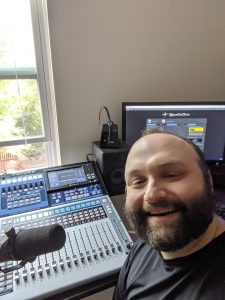
Randy Hanley is the founder and host of the Manly Hanley podcast. He’s been using Studio One and a StudioLive mixer to produce the show, and sent us a TON of info on his production method and why he’s chosen PreSonus. If you’re looking to get into Podcasting, this is a great read.
Give us some background on yourself. Who are you, what do you do, and how long have you been podcasting?
I started out as a drummer, professionally teaching at music stores for 12 years. Drums lead me to learn about computers and technology through my interest in recording. I received a certificate at the Recording Institute of Detroit, back when we were still using mini ADAT Recorders, just when a software that rhymes with “Mo’ Jewels” was becoming “the thing.” There was just something about Mo’ Jewels that I was never able to become comfortable with.
I heard of PreSonus, when a music store colleague of mine mentioned that he was going to buy the ACP 88 Compressor. I didn’t even know what it was at the time, but he explained it to me, how it offered all of this compression/multiple channels, at an extremely great value. That’s basically the very first time I heard of PreSonus.
I started a Podcast back in 2011 called “Getting Android,” but I never followed through with it. After I bought my PreSonus FireStudio Project rig for recording music, I realized that I have way more than enough power/setup to do a simple podcast, so why not give it a try? Well, I eventually got around to it, in 2019 and I’m glad I did. I’m more of a reborn podcaster, so technically, I’ve been doing it (consistently) since January.
What PreSonus products do you use?
I use Studio One 4.5 Artist and the StudioLive 16, Series III. I originally started with the FireStudio Project.
What features, in particular, make StudioLive and Studio One suitable for podcasters?
The Templates, ease-of-use, and the perfect integration between Studio One and basically ANY hardware interfaces.
For Podcasting, I’ve created my own template, which you can see below.
What I think really makes PreSonus Studio One accessible to Podcasters? It’s future-proof. For instance, many podcasters move into doing more with their podcast, and that often includes Video/Vlogging. With the Professional edition of Studio One, you have all you need to not have to jump between programs! It’s tiring to jump back and forth from Camtasia (because its audio features are terrible), just to grab the audio file from a DAW. Studio One has it all there in one place. I won’t have to worry about sync issues, or format confusion, because the recent format additions in Studio One 4.5 are amazing and all I’ll ever need.
I also have noticed that Studio One is easy on the CPU/RAM resources–which I think is very important to us Podcasters–My machine isn’t a video-rendering beast–I just use it to record audio and Studio One is extremely fast, even on my somewhat modest machine.

I never feel like I’m lost with the way I can label things. It’s easy enough for my co-host to sit a tablet on the StudioLive and remotely control the faders of the mixer if we need to fix levels. Additionally, the labels on the mixer can reflect what I’ve named them in Studio One. I feel like there is always a way for me to get the job done with PreSonus.
Before I purchased the StudioLive 16, I thought to myself that this might be total overkill to use for a podcast. But then I thought back to how many products I’ve wasted my money on over the years, such as cheaper USB microphones. All of the money I spent on those products easily cost more than just buying this mixer, which includes Studio One anyway. It was a no-brainer. (Incidentally, I recently heard that PreSonus dropped the price on some of the Series III mixers as much as $200.)
Additionally, I was frequenting some Facebook podcasting groups, seeing which kind of problems users commonly had. Users were always running into issues setting up Audacity. Users also ask questions about “Where do I get my Podcast edited, produced, normalized, compressed…” the list went on an on. I realized I could do ALL of the above in Studio One. It’s a HUGE money-saver when it comes to producing my own podcast. I’m not paying anyone to do anything other than advertising and host my Podcast. The way I’m looking at it, I’m saving a ton of money each and every month producing it on my own. With my plug-ins and templates inside of Studio One, I don’t really have to do much editing, ever!
I heard so many good things about Studio One, especially that it was included with many of the hardware products that PreSonus sells and integrates well. Studio One can open projects from other DAWs such as Cubase, Pro Tools and others.
 I also never have to worry about running out of inputs. I don’t know of a podcast that has 16 people talking at once ?.
I also never have to worry about running out of inputs. I don’t know of a podcast that has 16 people talking at once ?.
Also, with Studio One and my PreSonus hardware interface working with USB is the big sell for me doing this podcast. USB just works. I haven’t had to install any legacy drivers, etc.
What features are you most impressed with?
Ease-of-use and stability! Never crashes on me… EVER!
I am really impressed with how the StudioLive mixer has recall of the effects and fader positions–it doesn’t have to rely on my computer and Studio One’s project settings if I feel like just using the mixer as a LIVE MIXER. But then, if I want to jump into DAW mode, I can make the mixer follow the computer’s settings. There is so much flexibility, it’s crazy. I cannot think of anything I need. I’m also impressed that PreSonus uses AVB, an open standard that allows any vendor to support it. It’s not closed-minded and just feels like freedom. I’m an open-source guy whenever possible–it’s transparent and honest.
Oh, here’s a bonus feature: the community. The PreSonus forums are the best support you could ask for. When I started out with Studio One and my StudioLive mixer, I had a couple basic question. Embarrassingly, the answers were in the manual that came with the mixer, but the community was friendly and helped point me in the right direction. It’s like a small town of nice people wanting to help because they share similar passions, supporting this company that cares about its customers.
Any user tips or tricks or interesting stories based on your experience with PreSonus hardware and software?
I recorded some amazing bluegrass artists on some of the old FireStudio hardware and it still sounds phenomenal today.
As for tips, I’m a HUGE believer in templates. That’s the best way to be productive and save so much time. PreSonus templates are the best.
For Podcasting, I literally have to do zero cleanup. I have my effects set on the mixer (I typically use the Male Voice 1 or 2) and it applies just the right amount of compression and gating. I can do these effects on each individual Mic channel for each podcast co-host. I receive lots of compliments on how nice and clear the audio is. I share my experience often in some Podcast Support groups on Facebook, including this one.
What features do you want to see next in Studio One or StudioLive?
I’d like to maybe just a see a few more default templates, that are Podcast-specific, heck, I’ll share mine with any other Podcasters, just shoot me a message.
What’s next for you?
I hope to learn my mixer / DAW more. I want to do a live podcast eventually. I’d like to use the SD Card feature on the StudioLive mixer, because I know that Studio One makes it easier than ever to take those recordings, directly off the SD card, then opening the project, ready-to-edit on my computer!
Advanced EarMix 16M Routing for Whole-Band Scenarios
To learn more about the EarMix 16M, click here!
Richard Gaspard takes you on a deep dive on configuring and using the EarMix 16M for a whole band scenario in this five-part series. Check it out!
